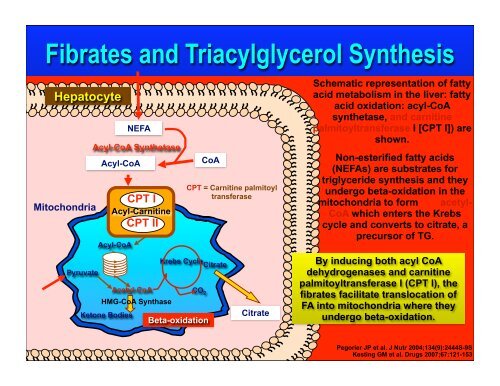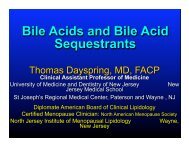Fibrate Mechanism of Action - The Center for Cholesterol Management
Fibrate Mechanism of Action - The Center for Cholesterol Management
Fibrate Mechanism of Action - The Center for Cholesterol Management
Create successful ePaper yourself
Turn your PDF publications into a flip-book with our unique Google optimized e-Paper software.
<strong>Fibrate</strong>s and Triacylglycerol Synthesis<br />
Hepatocyte<br />
Mitochondria<br />
Pyruvate<br />
NEFA<br />
Acyl-CoA Synthetase<br />
Acyl-CoA<br />
CPT I<br />
Acyl-Carnitine<br />
CPT II<br />
Acyl-CoA<br />
Acetyl-CoA<br />
HMG-CoA Synthase<br />
Ketone Bodies<br />
CoA<br />
CPT = Carnitine palmitoyl<br />
transferase<br />
Krebs Cycle<br />
Citrate<br />
CO 2<br />
Beta-oxidation<br />
Citrate<br />
Schematic representation <strong>of</strong> fatty<br />
acid metabolism in the liver: fatty<br />
acid oxidation: acyl-CoA<br />
synthetase, and carnitine<br />
palmitoyltransferase I [CPT I]) are<br />
shown.<br />
Non-esterified fatty acids<br />
(NEFAs) are substrates <strong>for</strong><br />
triglyceride synthesis and they<br />
undergo beta-oxidation in the<br />
mitochondria to <strong>for</strong>m acetyl-<br />
CoA which enters the Krebs<br />
cycle and converts to citrate, a<br />
precursor <strong>of</strong> TG.<br />
By inducing both acyl CoA<br />
dehydrogenases and carnitine<br />
palmitoyltransferase I (CPT I), the<br />
fibrates facilitate translocation <strong>of</strong><br />
FA into mitochondria where they<br />
undergo beta-oxidation.<br />
Pegorier JP et al. J Nutr 2004;134(9):2444S-9S<br />
Kesting GM et al. Drugs 2007;67:121-153



